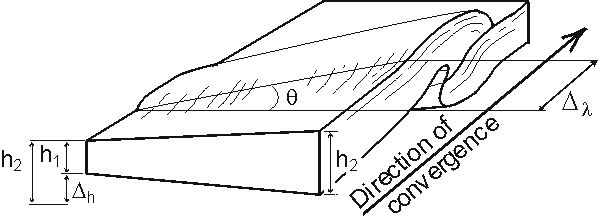Indentaion of a continent with a built-in thickness change:
experiment and nature.
Sokoutis D., S. E. Medvedev, M. Bonini, M. Boccaletti,
C. J. Talbot & H. Koyi.
This
paper deals with an analogue model aimed to investigate the influence of
variations in crustal thickness during continental convergence. 
The most popular explanation of orogens oblique to the convergence direction
is that sutured continental margins were also oblique to the convergence
direction. This paper introduces a new factor that may be involved in oblique
orogens: a variation in integrated strength in a direction perpendicular
to the regional convergence direction. The wavelengths of compressional
structures in the lithosphere depend on the thickness of its most competent
layers. Lateral variations in thickness must therefore induce oblique structures
during continental convergence. Several sectors along the Alpine-Himalayan
orogenic belt have this configuration.
An analogue experiment was performed to illustrate this model. This experiment
was based on a three-layer analogue of the lithosphere: an upper crust
of sand, a lower crust of a high-viscous polymer and a mantle of syrup
with low viscosity. The model was constracted with an initial built-in
thickness variations in the sand layer and shortened in the direction perpendicular
to these variations. The shortening was performed by moving one wall while
other walls remained fixed. The model scaling and interpretation were based
on the ETSA and standard theories of faulting.
The interaction between external (lateral push) and internal (buoyancy)
forces complicates the deformations. These deformations were subdivided
into several stages and the most significant forces were analysed during
each stage.
A system of faults sheared the brittle sand layer into a pattern of blocks
which deformed little. Kinematics of faults varied during the experiment
and subdivided the deformation into several stages in which mainly vertical
and mainly lateral escape alternate. A domain in front of the moving wall
converted the translational movement of the external rigid indenter into
an effective indenter. The main thrust belt bounding the effective indenter
evolved from two fold-faults belts of different wavelengths and merged
to an "orogenic wedge" essentially oblique to the direction of external
push.
The influence of the viscous layers was less recognisable then the sand
layer during the experiment and requires further analysis. Application
of the ETSA allows estimation of the different rates of isostatic adjustment
and gravity spreading controlled mainly by viscous layers. It is also demonstrates
that such investigations are impossible using thin sheet approximations
of a lower order.
As a collateral result of these investigations, the ETSA gives a
the channel flow solution for the two viscous layers perturbed in the upper,
much more viscous, fluid. Bird (1991) and Kaufman and Royden (1994) applied
variations of the MS approach to a similar problem to estimate lower crustal
flow during deformations of the lithosphere. These analyses were successful
because they used complicated rheologies. The ETSA is more appropriate
than the MS approach because it can handle large variations of viscosity
and allows solutions for even linear viscous fluids.
The analysis of forces and deformations in the analogue experiment demonstrates
that similar deformations can contribute to natural orogens developing
oblique to their convergence direction. Results of the experiment were
compared with natural orogenic complexes in Iran , Tunisia and the Eastern
Alps.
